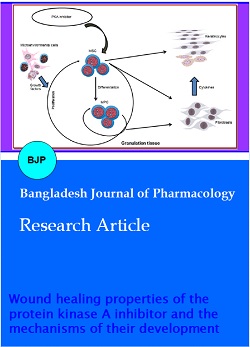Wound healing properties of the protein kinase A inhibitor and the mechanisms of their development
DOI:
https://doi.org/10.3329/bjp.v16i2.50575Keywords:
Microenvironment cell, Protein kinase A, Progenitor cell, Regenerative medicine, Skin woundAbstract
The regenerative activity of the protein kinase A inhibitor was investigated using externally on the model of the flap skin wound. The pronounced wound healing effects of the protein kinase A inhibitor had been revealed. They are based on the activation of mesenchymal progenitor cells. The development of this phenomenon was associated with the direct influence of the protein kinase A inhibitor on mesenchymal progenitor cells. The most significant stimulation of their growth potential occurred in the context of the impact of growth factors in particular fibroblast growth factor secreted by the stromal cells. Moreover, in situ, there was an increase not only in proliferating activity but also in the intensity of the specialization processes of progenitors. Without cytokines stimulation, the change in the pattern of cellular cAMP-mediated signal does not affect the maturation rate of precursors.
Downloads
211
152

Downloads
Published
How to Cite
Issue
Section
License
Authors who publish with this journal agree to the following terms:
- Authors retain copyright and grant the journal right of first publication with the work simultaneously licensed under a Creative Commons Attribution License that allows others to share the work with an acknowledgement of the work's authorship and initial publication in this journal.
- Authors are able to enter into separate, additional contractual arrangements for the non-exclusive distribution of the journal's published version of the work (e.g., post it to an institutional repository or publish it in a book), with an acknowledgement of its initial publication in this journal.
- Authors are permitted and encouraged to post their work online (e.g., in institutional repositories or on their website) prior to and during the submission process, as it can lead to productive exchanges, as well as earlier and greater citation of published work (See The Effect of Open Access).
